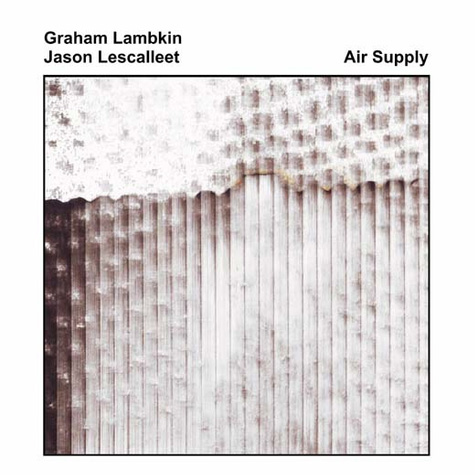Graham Lambkin/Jason Lescalleet, "Air Supply"
 A strange spectacle murmurs unceremoniously just beneath the familiar hum of daily life. It's filled with little dramas and peculiar collisions that sneak by unnoticed—in the empty spaces of the room, out of the corner of your eye—small bits of information slip through the senses' fingers and fall into the subconscious where they become fodder for dreams. These unremembered fragments are a part of every environment and every observation, but would we recognize them if given a second chance? On Air Supply, Graham Lambkin and Jason Lescalleet resurrect such mental refuse and put just such a question to the test. They may have pointed their microphones at computer vents or the back yard, but what they pulled from those sources is utterly bizarre, to the point of being completely alien.
A strange spectacle murmurs unceremoniously just beneath the familiar hum of daily life. It's filled with little dramas and peculiar collisions that sneak by unnoticed—in the empty spaces of the room, out of the corner of your eye—small bits of information slip through the senses' fingers and fall into the subconscious where they become fodder for dreams. These unremembered fragments are a part of every environment and every observation, but would we recognize them if given a second chance? On Air Supply, Graham Lambkin and Jason Lescalleet resurrect such mental refuse and put just such a question to the test. They may have pointed their microphones at computer vents or the back yard, but what they pulled from those sources is utterly bizarre, to the point of being completely alien.
"Because the Night" starts the show with an illusion. It's cold outside. Someone is walking down a crunchy dirt road in heavy boots, the fabric of his thick winter coat audibly brushing against itself as he goes. He picks up an old shovel and begins digging a hole, or maybe shoveling snow. A chilly hum floats in the air, a substitute for the icy temperature outside. As he digs, a slow, warbling howl suddenly and shockingly pierces the scene. It moans, then fades, then retreats into the distance. The perspective shifts. Someone tinkers with a plastic box, presses a button, and the activity stops. There's only that transparent blue tone in the air, and a few quiet noises beeping somewhere in the distance. Winter at the Lescalleet home in Berwick, Maine, where Air Supply was recorded, seems just a tad frightening.
Only the liner notes tells us that the album was recorded in late May of 2010. It's unlikely there was any snow on the ground to shovel. The fabric noise could be coming from torn sheets of paper, the crunch of boots on gravel might actually be the sound of someone walking through piles of leaves, and who knows where the animal moan came from, but it doesn't sound dubbed in. Whatever it was, it was right there, in range of the microphone.
Air Supply deals almost exclusively in these kinds of anonymous noises and illogical, imagination-confounding combinations. Unlike the music of The Breadwinner, this music conceals its origins, making identification difficult. There are no bathrooms, no kitchen utensils, no fireworks down the street—nothing with which to get your bearings—just a yarn of half-recognizable threads that unravel in unpredictable ways. And little attempt is made to make the unfamiliar sound familiar. Air Supply reintroduces the mundane, forgotten, and ignored ephemera of daily mindlessness to the conscious mind without the assistance of context or narrative. Divorced from the places in which they first arose, these noises come to us like pieces in a puzzle.
It's tempting to think the idea is to find a way to make those pieces fit together, but they're fragmentary by nature. If the pieces could be reassembled from the few recognizable bits, it's unlikely they'd form a coherent picture anyway. The album cover, title, and song names all parallel that fact. The title and artwork reference a Brian Eno and Robert Fripp bootleg, the opening song's title could be a nod to Patti Smith, or maybe Bruce Springsteen, and the title also points to Australia's best known soft rock duo, whose primary songwriter and guitarist is also named Graham.
The un-connectable dots move from the titular references and into the music when Lambkin and Lescalleet show up in "Color Drop" talking about VHS tapes. There they expose themselves as sound sources and as manipulators. Jason's mouse-clicking stops the looping melodic fragments that started the song and, for a brief moment, the whir of his computer fan fills the room. That little tidbit lets the listener in on the process behind the song for just a moment. The spaces and noises inside the Lescalleet home aren't just being captured, they're being created too; arranged and re-arranged in ways that would normally be impossible. The process matters. It's a part of the music, not just an invisible force behind it. So we get to hear the process as part of the finished work, which throws the idea of a finished work into question.
Consequently, the neat division between music and the clamor of waking life meets a firm roadblock in these songs, just as it did with The Breadwinner. Lambkin and Lescalleet's music contains melody of a kind, and rhythms too. Language and thought are more than flexible enough to accommodate the duo's harmonies. Yet they derive their material from noise, and not even the common sort. Rather than breaking down the sound of appliances and making music that way, they start with the scraps and build their environments up.
The audible chugging of a computer's hard drive is the sort of thing most people attempt to drown out. Internet message boards have enormous threads devoted entirely to the topic of filtering out mechanical nuisances, radio interference, and other such small things. People go to all kinds of extremes to hush these sounds up. But on Air Supply they all intermingle quite beautifully and often quite confusingly: with the sound of a resonant gong, birds outside, someone pounding a rubber ball into concrete, and all the phantom activities caught in the album's central temperature trilogy—a sequence as baffling and as intriguing as they come. And tinged with a dark undercurrent too: the passing shadow of something that the ear registers, but that the mind is always racing to catch.
samples:
 



